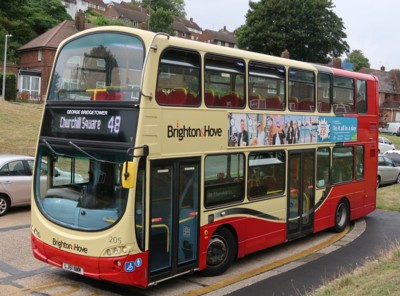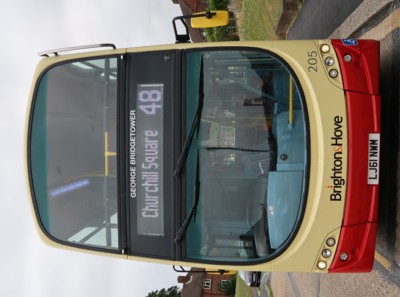

205 George Bridgetower
Connections with Brighton and Hove :
George Augustus Polgreen Bridgetower was born on 11 October 1778, in Biała Podlaska, Poland, where his father worked for Prince Hieronim Wincenty Radziwiłł. He was baptised Hieronimo Hyppolito de Augusto on 11 October 1778. His father, John Frederick Bridgetower (né Joannis Friderici de Augusto Æthypois), was probably a West Indian (possibly from Barbados), although he also claimed to be an African prince, as stated in George's baptismal record.
From 1779 John Frederick was a servant of the Hungarian Prince Esterházy, the patron of Joseph Haydn. George's mother, Maria Anna Ursula Schmidt, was from Swabia, now in Germany, described as a "Polish lady of quality", from the "noble Polish House of Schmidt". She was later possibly a domestic worker in the household of Sophie von Thurn und Taxis, who married Prince Hieronim Wincenty Radziwiłł in 1775. George moved to London at an early age and was performing as a violin soloist at the Drury Lane Theatre by the age of 10.
He exhibited considerable talent while still a child and gave successful violin concerts in Paris, London, Bath and Bristol in 1789. In 1791, the British Prince Regent, the future King George IV, took an interest in him and oversaw his musical education. At the Prince's direction, he studied under François-Hippolyte Barthélémon, the leader of the Royal Opera, with Croatian-Italian composer Giovanni Giornovichi, and with Thomas Attwood, organist at St Paul's Cathedral and professor at the Royal Academy of Music. Bridgetower performed in around 50 concerts in London theatres, including Covent Garden, Drury Lane and the Haymarket Theatre, between 1789 and 1799, and he was employed by the Prince to perform in his orchestra in Brighton and London.
In the spring of 1789, Bridgetower performed to great acclaim at the Abbaye de Panthemont in Paris, with Thomas Jefferson and his family in attendance.
He was given leave to visit his mother and brother, Friedrich Joseph Bridgetower, a cellist, in Dresden, in 1802, and he gave concerts there as well. He visited Vienna later in 1803, where he performed with Ludwig van Beethoven. Beethoven was impressed with his talent and dedicated his Violin Sonata No. 9 in A minor (Op.47) to Bridgetower, with the jocular dedication "Sonata mulattica composta per il mulatto Brischdauer, gran pazzo e compositore mulattico" ("Mixed-race sonata composed for the mixed-race Bridgetower, great fool and mixed-race composer"). Though Beethoven had barely completed the composition, the piece received its first public performance at a concert in the Augarten on 24 May 1803 at 8:00 AM, with Beethoven on pianoforte and Bridgetower on violin. Bridgetower had to read the violin part of the second movement from Beethoven's copy, over his shoulder. He made a slight amendment to his part, which Beethoven gratefully accepted, jumping up to say "Noch einmal, mein lieber Bursch!" ("Once more, my dear fellow!"). Beethoven also presented Bridgetower with his tuning fork, now held by the British Library.
According to violinist J.W. Thirlwell writing over 50 years later, the pair fell out soon afterwards, after Bridgetower insulted a woman who turned out to be Beethoven's friend; Beethoven broke off all relations with Bridgetower and changed the dedication of the new violin sonata to the violin virtuoso Rudolphe Kreutzer, who never played it, saying that it had already been performed once and was too difficult. The piece is now known as the Kreutzer Sonata.
Bridgetower returned to England, continued his musical career by teaching and performing, and was elected to the Royal Society of Musicians on 4 October 1807. He attended Trinity Hall, Cambridge where he earned the degree of Bachelor of Music in June 1811.
He performed in the Philharmonic Society (later to become the Royal Philharmonic Society) of London's first season in 1813, leading the performance of Beethoven's Quintet, and subsequently married Mary Leech Leeke in 1816.
He later travelled abroad, particularly to Italy, where his daughter lived.
He died in 1860 in Peckham, south London, leaving his estate of £1,000 (equivalent to £99,930 in 2021) to his deceased wife's sister. The house was demolished in 1970. He is buried in Kensal Green Cemetery.
205 Volvo Gemini - carried name since May 2023.
Names on the buses

